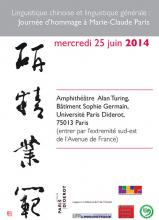Journée d’hommage à Marie-Claude Paris
Amphithéâtre Alan Turing,
Bâtiment Sophie Germain
Université Paris Diderot,
75013 Paris
9h30 Accueil
10h00 Ouverture
10h15 Alain Peyraube (CRLAO, CNRS-EHESS)
A comparative analysis of the case system in some Northwestern Sinitic languages
11h15 Pause
11h30 Hommage 1
12h30 Pause déjeuner
14h30 Stephen Matthews (Université de Hong Kong)
Parisian explorations in verb-fronting
15h30 Hommage 2
16h Pause
16h15 Hommage 3
17h15 Walter Bisang (Université Johannes Gutenberg de Mayence)
Sur l’interaction entre syntaxe, sémantique et pragmatique et ce que l’on peut apprendre du chinois
18h15 Clôture
18h30 Pot
Abstracts
Alain Peyraube (CRLAO, CNRS-EHESS)
A comparative analysis of the case system in some Northwestern Sinitic languages
The Qinghai-Gansu border region in China (western part of Qinghai province, southern part of Gansu province) contains several languages descended from at least four different language taxa: Sinitic, Tibeto-Burman (Amdo Tibetan), Turkic, Mongolic. Given the frequent contacts and intermarriage of Han (Chinese) peoples and Altaic and Tibetan peoples since the beginning of our era, large scale linguistic interference have inevitably occurred at different periods of time.
It is not surprising that taken individually, most of the region’s languages do not seem to conform to the given typological profile of their language family, for each has a set of linguistic features which seem to be drawn from more than one source, historically. Moreover, if we compare the structural features (especially syntactic features) of the languages throughout the region, we find that these are shared by most of the local language varieties. Thus, there appears to be a regional typological coherence, which can be considered to be a prototypical Sprachbund, or linguistic area.
This paper will examine one of the most characteristic syntactic properties of the languages, namely the case system for the following Sinitic languages: Hezhou [or Linxia], Tangwang, Wutun, Gangou, that have been sometimes viewed as ‘mixed languages.’
An answer to the following main questions will be tentatively suggested in the conclusion: Do we really have case suffixes in these languages (cases are a morphological notion) or simply thematic roles expressed by postpositions (thematic roles are a semantic notion)? Do we really have a Qinghai-Gansu linguistic area? Can these Sinitic languages be characterized as being mixed languages?
Stephen Matthews (Université de Hong Kong)
Parisian explorations in verb-fronting
Verb-fronting denotes a class of constructions in which the verb appears once in a fronted position and again in its base position, as in (1-2):
(1) Ta lian chi dou bu chi le
Il ne mange même plus (Mandarin, Paris 1981)
(2) Leng jauh leng, batgwo jauh gwai-jo di
It does look nice, it’s just a bit expensive (Cantonese, Matthews & Yip 2011)
Despite important contributions by Marie-Claude Paris, these phenomena remain largely absent from grammatical descriptions of Chinese and other languages in which they occur. They are also poorly understood relative to other ares of Chinese grammar. Do they involve topicalization, focusing or both? How are they related to other verb-copying constructions in Chinese and to predicate clefts in creole and West African languages? And what theoretical implications do they have for Chinese and for general linguistics? Some answers to these questions will be suggested based primarily on engagement with Cantonese and Mauritian creole.
Walter Bisang (Université Johannes Gutenberg de Mayence)
Sur l’interaction entre syntaxe, sémantique et pragmatique et ce que l’on peut apprendre du chinois
Les théories sur l’architecture de la grammaire se concentrent sur l’interaction entre des niveaux grammaticaux tels que la syntaxe, la sémantique et l’inférence pragmatique. Ce qui n’est discuté que très rarement est l’importance relative de ces niveaux et la question s’il y a des différences typologiques. Cette présentation propose l’hypothèse que l’importance de l’inférence pragmatique des catégories grammaticales peut varier dans les langues du monde et que les langues de l’Asie orientale et de l’Asie du sud-est sont caractérisées par une importance particulièrement élevée de l’inférence pragmatique. Ça ne se montre pas seulement dans la multifonctionnalité de certaines marques grammaticales et dans le fait que beaucoup de catégories ne sont pas obligatoires (p. ex. pro-drop radical, marques aspecto-temporelles), mais aussi dans la forme d’interaction entre les niveaux grammaticaux.





